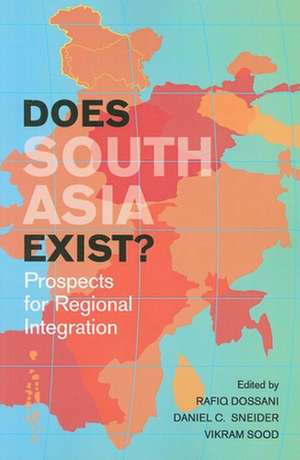Does South Asia Exist?: Prospects for Regional Integration
Editat de Rafiq Dossani, Daniel C. Sneider, Vikram Sooden Limba Engleză Paperback – 13 aug 2010
Does South Asia exist? Globally, regional integration and prominent regional institution—such as the European Union and the Association of Southeast Asian Nations—have been on the rise. In South Asia, by contrast, such progress has been slow, despite the recent dynamic growth of India's economy.
This broad-based volume examines the prospects for regionalism in South Asia, assessing issues that drive greater regional integration and obstacles that prevent it. How does South Asia's experience of regionalism compare with other parts of the world? What different perspectives do South Asia's sometimes contentious neighbors bring to the regional process? How do those attitudes help or hinder solutions to peculiarly South Asian challenges? The book devotes particular attention to India, the largest power in the region, and analyzes the extent to which it drives or blocks greater regionalism. As the book's distinguished contributors reveal, the provocative question at the heart of this timely book defies easy answers.
Copublished with the Observer Research Foundation, New Delhi.
This broad-based volume examines the prospects for regionalism in South Asia, assessing issues that drive greater regional integration and obstacles that prevent it. How does South Asia's experience of regionalism compare with other parts of the world? What different perspectives do South Asia's sometimes contentious neighbors bring to the regional process? How do those attitudes help or hinder solutions to peculiarly South Asian challenges? The book devotes particular attention to India, the largest power in the region, and analyzes the extent to which it drives or blocks greater regionalism. As the book's distinguished contributors reveal, the provocative question at the heart of this timely book defies easy answers.
Copublished with the Observer Research Foundation, New Delhi.
Preț: 250.76 lei
Nou
Puncte Express: 376
Preț estimativ în valută:
47.98€ • 50.20$ • 39.86£
47.98€ • 50.20$ • 39.86£
Carte tipărită la comandă
Livrare economică 02-16 aprilie
Preluare comenzi: 021 569.72.76
Specificații
ISBN-13: 9781931368179
ISBN-10: 1931368171
Pagini: 350
Ilustrații: Illustrations
Dimensiuni: 152 x 229 x 20 mm
Greutate: 0.46 kg
Editura: Brookings Institution Press
Colecția Shorenstein Asia-Pacific Research Center
ISBN-10: 1931368171
Pagini: 350
Ilustrații: Illustrations
Dimensiuni: 152 x 229 x 20 mm
Greutate: 0.46 kg
Editura: Brookings Institution Press
Colecția Shorenstein Asia-Pacific Research Center
Notă biografică
Rafiq Dossani is a senior research scholar at Shorenstein APARC, responsible for developing and directing the South Asia Initiative. His most recent books are India Arriving (2007), Prospects for Peace in South Asia (coedited with Henry Rowen, 2005), and Telecommunications Reform in India (2002).
Daniel C. Sneider is the associate director for research at Shorenstein APARC. Sneider is a former foreign correspondent for the Christian Science Monitor and former foreign affairs columnist of the San Jose Mercury News. Vikram Sood is vice president of the Centre for International Relations at the Observer Research Foundation, an independent public policy think tank. Previously, he served as a career intelligence officer, heading the Research and Analysis Wing, India's external intelligence service.
Daniel C. Sneider is the associate director for research at Shorenstein APARC. Sneider is a former foreign correspondent for the Christian Science Monitor and former foreign affairs columnist of the San Jose Mercury News. Vikram Sood is vice president of the Centre for International Relations at the Observer Research Foundation, an independent public policy think tank. Previously, he served as a career intelligence officer, heading the Research and Analysis Wing, India's external intelligence service.
Descriere
Does South Asia exist? Globally, regional integration and prominent regional institution—such as the European Union and the Association of Southeast Asian Nations—have been on the rise. In South Asia, by contrast, such progress has been slow, despite the recent dynamic growth of India's economy.
This broad-based volume examines the prospects for regionalism in South Asia, assessing issues that drive greater regional integration and obstacles that prevent it. How does South Asia's experience of regionalism compare with other parts of the world? What different perspectives do South Asia's sometimes contentious neighbors bring to the regional process? How do those attitudes help or hinder solutions to peculiarly South Asian challenges? The book devotes particular attention to India, the largest power in the region, and analyzes the extent to which it drives or blocks greater regionalism. As the book's distinguished contributors reveal, the provocative question at the heart of this timely book defies easy answers.
Copublished with the Observer Research Foundation, New Delhi.
This broad-based volume examines the prospects for regionalism in South Asia, assessing issues that drive greater regional integration and obstacles that prevent it. How does South Asia's experience of regionalism compare with other parts of the world? What different perspectives do South Asia's sometimes contentious neighbors bring to the regional process? How do those attitudes help or hinder solutions to peculiarly South Asian challenges? The book devotes particular attention to India, the largest power in the region, and analyzes the extent to which it drives or blocks greater regionalism. As the book's distinguished contributors reveal, the provocative question at the heart of this timely book defies easy answers.
Copublished with the Observer Research Foundation, New Delhi.








